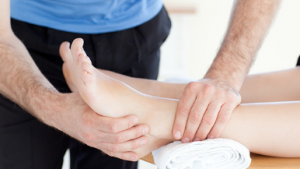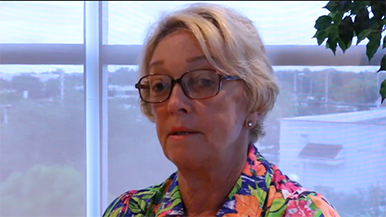Cindy can now do the small, everyday things that normally fly under the radar for most people. She credits the transformation in her quality of life to Craig J. Breslauer, DPM, FACFAS, CWS, a board-certified foot and ankle surgeon at South Florida Orthopaedics & Sports Medicine. (Dr. Breslauer is the only physician on The Treasure Coast to hold the highest achievement in foot & ankle surgery: Board Certified in Reconstructive Rearfoot & Ankle Surgery by The American Board of Foot & Ankle Surgeons).
“The biggest benefit of Dr. Breslauer’s expertise has been that I can walk and even run a little bit,” says Cindy. “I can do all my chores and the things I was doing before that you take for granted, like walking up and down stairs. I can do that now.”
How Is Reconstructive Ankle Surgery Performed?
The ankle and foot are held together by a complex network of ligaments and tendons on both the inside and outside of the ankle. The ligaments are strong, fibrous tissues that connect bones to other bones, keep the ankle stable, and help restrict its motion. When they get stretched or torn, the ligaments can weaken and get sprained, which can lead to instability of the ankle over time, especially after repeated ankle sprains or with specific foot deformities.
 When one or more ankle ligaments become loose or overstretched it can cause:
When one or more ankle ligaments become loose or overstretched it can cause:
- Chronic ankle pain
- Arthritis
- Persistent ankle instability (an ankle that often gives way when walking or when engaging in other activities)
If the ligament tears or ankle instability becomes extreme enough, it may require surgery. In most cases, a foot and ankle surgeon will be able to repair the torn ligaments with sutures and anchors that reattach the ligaments to the bone. An ankle arthroscopy is typically performed at the same time which is a minimally invasive surgery utilizing a small camera and instruments. Two less than 1” incisions are made over the ankle joint and the inside of the joint is explored. Any problems such as cartilage damage and bone spurs are addressed. When a ligament is damaged beyond repair, it will be reconstructed by replacing it with a tissue graft harvested from other tendons found in the foot and around the ankle or by using commercially available tendon grafts.
“I feel very fortunate that I’ve had this great experience,” says Cindy. “Dr. Breslauer is a wonderful doctor in his ability to put back together something that was unrecognizable. He’s always concerned about how I am and if any new issues arise. He talked to me all the time, not as a doctor, but as somebody who’s really interested in making sure that I am healing correctly.”
Recovering After Reconstructive Ankle Surgery
After ankle reconstruction surgery, patients will be on crutches for about four to six weeks. Afterward, they will typically progress to a removable surgical boot or cast to keep the ankle stable. After another few weeks, patients will transfer to a normal shoe or ankle brace to support the ligament as it heals; this process can take anywhere from several weeks to a few months.
 Cindy appreciates the continuous support she received from Dr. Breslauer as well as the close relationships she has developed with the entire South Florida Orthopaedics & Sports Medicine team.
Cindy appreciates the continuous support she received from Dr. Breslauer as well as the close relationships she has developed with the entire South Florida Orthopaedics & Sports Medicine team.
“Dr. Breslauer is always a phone call away, and my calls are always returned within a couple of hours by somebody who is interested in my progression,” says Cindy. “The staff asks about your family, how you’re doing every day, and are you getting out to the grocery store. We have some laughs, and it’s not just all business. There is a lot of human interaction.”
After her successful reconstructive ankle procedure, Cindy is grateful for getting back to walking and living pain-free and for everything her and Dr. Breslauer have achieved together. “All of this has been a journey, but a good one,” she says. “I never felt discouraged. I never wanted to give up, and I didn’t want just to improve. I think a lot of that has to do with Dr. Breslauer and the kind of doctor he is.”
